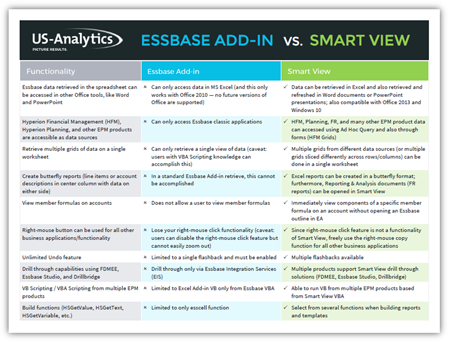When Oracle discontinued the Essbase Spreadsheet Add-in after the 11.1.2.2 version of Essbase, they added several new features to Smart View to make the transition beneficial for users. Here we outline the similarities and differences between the two products.
Similarities
The Essbase Add-In and Smart View both had a few of their own unique features, but they essentially did the same things:
- Both products boasted the ability to drill through member hierarchies within Excel. The drill-through feature is the staple that made the Essbase Add-In and Smart View useful — it gave the users a way to retrieve large amounts of data in an extremely short amount of time and allowed them to expand the dimension hierarchies.
- Both products featured Keep-only and Remove-only functions, which either kept or removed the selected cells in Excel.
- Essbase Add-In and Smart View also used the Member Selection function, Undo and Pivot functions, and ancestor positioning within the hierarchy.
Differences
Smart View has come a long way since the Essbase Add-In was discontinued. There are now many additional features in Smart View that have enhanced its capabilities:
- One of the bigger changes is that Smart View is now compatible with multiple Oracle and Microsoft products, whereas the Essbase Add-In only connected to Essbase and Excel.
- The Submit Data function is a new feature in Smart View that allows users to enter data in Excel and submit it to whichever product they are connected to. Submit Data makes simple data entries quick and easy. Users can also open data forms and task lists within Smart View and submit data from the data form, too.
- Another function within the updated Smart View is the ability to add members and edit their properties. Once the user submits a member or changes the member properties, the changes are automatically updated in whichever Oracle product the user is connected to.
- Users also have the ability to save their connections to their favorites and can connect to multiple connections at a time, another feature that the Essbase Add-In did not provide. There are two options with the multiple connection feature: users can have multiple sheets using different connections, or users can implement a multi-grid. A multi-grid allows for multiple connections on one Excel sheet. For example, a user could have a Hyperion Planning POV and an Essbase POV on the same Excel sheet to ensure that their numbers tie out between the application and the database.
- The Cascade feature in the Essbase Add-In essentially did the same thing as it does in Smart View, but now the tabs that are populated when the Cascade feature is run are displayed by their name, not a generic number. The added benefit allows users to know which tab contains which information/data.
- The data retrieval size in Smart View has substantially increased, allowing users to pull/retrieve more data at a faster rate than the Essbase Add-In provided.
- Smart View gives users the option to choose how the members are displayed in Excel. Users can choose from Member Name, Alias, Member Name and Alias, or Description, which gives the user a little more customization when working with their dimensions and POV.
Comparison chart
For a detailed comparison of Smart View and the Essbase Add-In, download our comparison chart:






